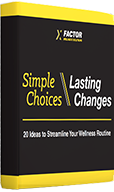Integrated Flexibility Training
Defining the Integrated Flexibility Continuum
The Purpose of Flexibility Training is to:
- correct muscle imbalances
- increase joint range of motion
- decrease muscle soreness
- decrease muscle hypertonicity
- relieve joint stress
- maintain normal functional length of all muscles

Types of Stretching:
1. Static Stretching- process of passively taking a muscle to the point of tension and holding the stretch for 30-60 sec.
2. Self-Myofascial Release Stretching- applying pressure to a tight muscle with a foam roll or a "stick" to improve soft tissue extensibility through "autogenic inhibition".
3. Neuro-Dynamic Stretching- Passively and actively stretching neural structures.
4. Active-Isolated Stretching- using agonists and synergists to dynamically move the joint into a range of motion which creates reciprocal inhibition of the functional antagonist and allows for greater range of motion.
5. Neuromuscular Stretching- (also known as Proprioceptive Neuromuscular Facilitation). Employes reciprocal inhibition and autogenic inhibition to improve range of motion.
6. Dynamic Stretching- uses force production of a muscle and the body's momentum to take a joint through the full available range of motion. Creates multiplanar soft tissue extensibility that is controlled by the central nervous system.
Failure to maintain normal tissue extensibility can result in the cumulative injury cycle. Cumulative Injury Cycle - is tissue trauma >Inflammation>Muscle Spasm>Muscle Adhesions>Altered Neuromuscular Control>Muscle Imbalance> More tissue trauma.
Following are 4 Components of Flexibility
1.Flexibility- the normal extensibility of all soft tissue that allows full range of motion of all joints.
2.Corrective Flexibility- Corrects postural dysfunctions, muscle imbalances and joint dysfunctions. Incorporates static stretching , self-myofascial release, neurodynamic stretching and neuromuscular stretching.
3.Active Stretching- designed to improve soft tissue extensibility in all planes of motion by employing the neurophysiological principle of reciprocal inhibition. Incorporates self-myofascial release (Foam Rolling), neuromuscular stretching and active-isolated stretching.
4.Functional Flexibility- Incorporates dynamic stretching and self-myofascial release.
Flexibility should progress from Corrective > Active > Functional
Pre-Workout
- Muscle Imbalances- SMR > Warm up > Static/Active Stretching >Training.
- No Muscle Imbalances-Active Isolated/Dynamic "goal specific" Flexibility > Training
During Workout
-
Active Isolated Stretching- to the antagonist.
Post-Workout
- SMFR (Form Roll/ the stick)
- Static Stretching
- Neuromuscular stretching (PNF)
| Integrated Flexibility Parameters | |
| Static | 2-4 reps @20-30 sec. hold |
| Neuromuscular | 25% agonist contraction, 7-10 sec. hold/ 20 sec. hold |
| Neurodynamic | 1 set x 4-6 reps@ 2 sec hold |
| SMR/ Stick | Hold 30 sec. per tender spot |
| Active | 1 set x 5-10 reps @1-2 sec. hold |
| Dynamic | 1 set x 5-10 reps (with body control) |
Reference:
NASM, Essentials of Perslnal Fitness Trainig (2008)
Clark, M. & Russell, A. Optimum Performance Training for the Performance Enhancement Specialist (3rd ed.) National Academy of Sports Medicine
The Integrated Training Series
- Integrated Dynamic Fitness Training
- Integrated Flexibility Training
- Integrated Core Training
- Integrated Balance Training
- Integrated Plyometric Training
- Integrated Speed, Agility, Quickness Training
- Integrated Strength Training
Latest X Factor post
Is your body saying you're old, but your mind isn't willing to give in? If you've ever felt discouraged by the challenges of health & fitness after 40, we've got a few tips, and a toolbox to help.
View BlogReceive "20 Ideas to Streamline Your Wellness Routine."
 Sign up for our "Weekly Wellness Tip" and get your free report "Simple Choices, Lasting Changes: 20 Ideas to Streamline Your Wellness Routine." The report gives you simple, smart ideas that can help you feel better and be more productive during your work day.
Sign up for our "Weekly Wellness Tip" and get your free report "Simple Choices, Lasting Changes: 20 Ideas to Streamline Your Wellness Routine." The report gives you simple, smart ideas that can help you feel better and be more productive during your work day.

Leave a Comment
Comments (0)